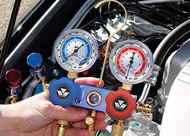How To Use HVAC Manifold Gauges?
28th Mar 2024
Ever wondered how to keep your HVAC system running smoothly? HVAC manifold gauges are a big part of the answer. These tools enable you to check the pressure of the refrigerant pressure in your system, crucial for preventing issues. Getting comfortable with how to use HVAC manifold gauges can save you from future headaches and costly repairs.
While using HVAC manifold gauges may initially seem complicated, it becomes straightforward with practice. This skill is significant for anyone who wants to ensure their heating and cooling system runs efficiently. It can save you trouble and help you control your heating and cooling costs.
Let’s begin with the steps for using HVAC manifold gauges in a way that's easy to remember.
How To Use HVAC Manifold Gauges?
Before discussing the specifics of using your HVAC gauges set, it's important to understand the task at hand clearly. Properly using these HVAC tools is crucial for efficiently diagnosing and maintaining your system. Being familiar with your HVAC tools list can make the process smoother and more effective.
Let's move on to the key steps to use your HVAC manifold gauges:
1- Connect the High-Pressure Hose
To start, hook up the red hose to the red port on your gauge set, designated for high pressure. This is crucial for accurately monitoring the high-pressure side of the system. Ensure you use the provided flare fittings provided with your HVAC equipment to securely attach the hose to the cooling unit's high-pressure port, which is uniquely sized to prevent mix-ups with the low-pressure side.
2- Set Up the Low-Pressure Hose
Next, attach the blue hose to the gauge's blue port, aligning with the low-pressure side of your cooling system. This connection is vital for accurately determining the system's vacuum pressure. It's designed to ensure the correct flow and measurement of vacuum pressure.
3- Attach the Vent Hose
For the third step, connect a black, low-pressure hose to the manifold's center port. This setup is necessary when you need to discharge the unit or vent freon, allowing for the connection of a refrigerant recovery bottle. It's an important process to comply with regulations on refrigerant release into the atmosphere.
4- Add Micron Meters or Vacuum Pumps
Finally, utilize the manifold's additional ports to attach micron meters or vacuum pumps. This allows for precise monitoring of vacuum pressure or facilitating repairs requiring vacuum pressure manipulation. This setup enhances your ability to effectively perform necessary maintenance or repairs on the cooling system.
How To Read HVAC Manifold Gauges?
HVAC gauges set are crucial, offering insights into an HVAC system's health by measuring refrigerant pressure levels. This information is crucial for identifying leaks or compressor malfunctions, which can impact system efficiency and lead to higher energy costs or costly repairs.
To read HVAC manifold gauges, start by observing the low-pressure (blue) gauge for vacuum and refrigerant suction, and the high-pressure (red) gauge, which reflects the refrigerant's discharge pressure. By comparing these readings to your system's recommended specifications, you can gauge the system's performance and pinpoint potential problems.
JB Tools - Top Place To Buy The Best HVAC Gauges For Sale!
At JB Tools, we recognize the significance of equipping your toolkit with the best HVAC tools. Building a perfect HVAC tools list may take time and effort for some. We are offering some of the industry's best HVAC equipment to make it easy. Among our top selections, you'll find FJC's best HVAC manifold gauges, renowned for their reliability and precision in diagnosing and maintaining HVAC systems.
JB Tools offers top-notch FJC manifold gauges at discounted prices with exclusive deals unmatched elsewhere. Shop now to take advantage of the best offers today on HVAC gauges!





